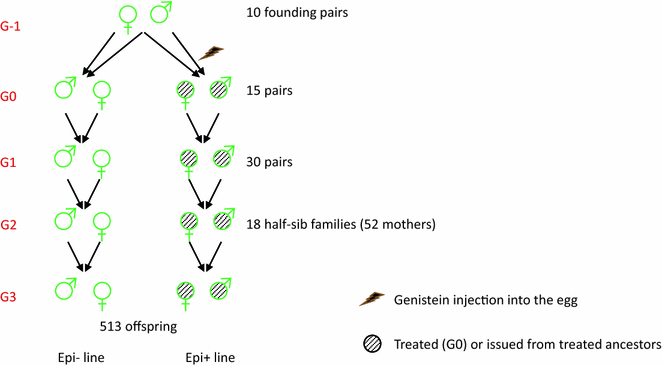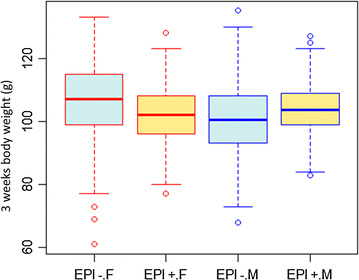Embryonic environment and transgenerational effects in quail
- PMID: 28125975
- PMCID: PMC5270212
- DOI: 10.1186/s12711-017-0292-7
Embryonic environment and transgenerational effects in quail
Abstract
Background: Environmental exposures, for instance to chemicals, are known to impact plant and animal phenotypes on the long term, sometimes across several generations. Such transgenerational phenotypes were shown to be promoted by epigenetic alterations such as DNA methylation, an epigenetic mark involved in the regulation of gene expression. However, it is yet unknown whether transgenerational epigenetic inheritance of altered phenotypes exists in birds. The purpose of this study was to develop an avian model to investigate whether changes to the embryonic environment had a transgenerational effect that could alter the phenotypes of third-generation offspring. Given its impact on the mammalian epigenome and the reproductive system in birds, genistein was used as an environment stressor.
Results: We compared several third-generation phenotypes of two quail "epilines", which were obtained from genistein-injected eggs (Epi+) or from untreated eggs (Epi-) from the same founders. A "mirrored" crossing strategy was used to minimize between-line genetic variability by maintaining similar ancestor contributions across generations in each line. Three generations after genistein treatment, a significant difference in the sexual maturity of the females, which, after three generations, could not be attributed to direct maternal effects, was observed between the lines, with Epi+ females starting to lay eggs later. Adult body weight was significantly affected by genistein treatment applied in a previous generation, and a significant interaction between line and sex was observed for body weight at 3 weeks. Behavioral traits, such as evaluating the birds' reaction to social isolation, were also significantly affected by genistein treatment. Yet, global methylation analyses revealed no significant difference between the epilines.
Conclusions: These findings demonstrate that embryonic environment affects the phenotype of offspring three generations later in quail. While one cannot rule out the existence of some initial genetic variability between the lines, the mirrored animal design should have minimized its effects, and thus, the observed differences in animals of the third generation may be attributed, at least partly, to transgenerational epigenetic phenomena.
Figures



References
-
- Feil R, Fraga MF. Epigenetics and the environment: emerging patterns and implications. Nat Rev Genet. 2012;13:97–109. - PubMed
MeSH terms
LinkOut - more resources
Full Text Sources
Other Literature Sources

